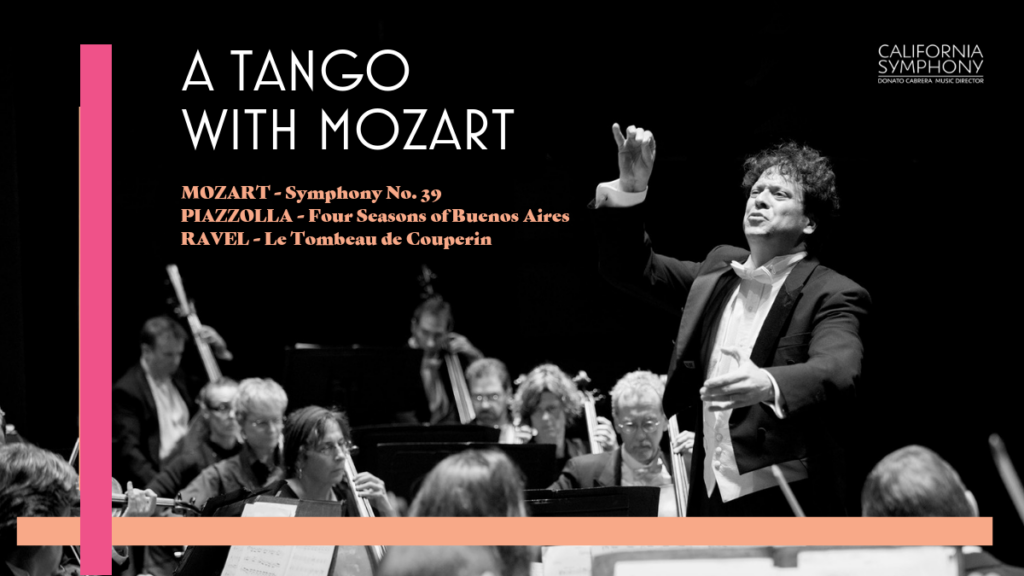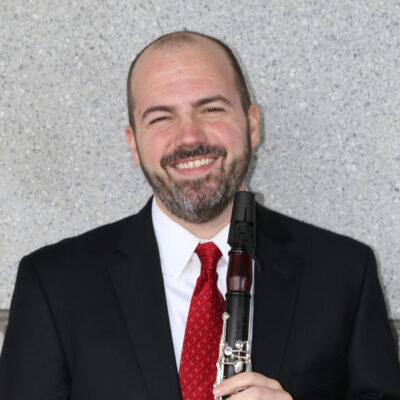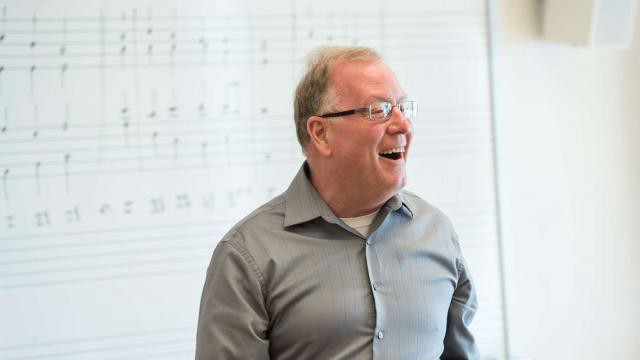
PROGRAM: A TANGO WITH MOZART
Saturday, January 19 at 8PM and Sunday, January 20 at 4PM, at the Lesher Center in Walnut Creek
- Le Tombeau de Couperin (1917) (orch. Ravel, 1919)–by Maurice Ravel (1875–1937)
- The Four Seasons of Buenos Aires (arr. Leonid Desyatnikov)–by Astor Piazzolla (1921–1992)
- Symphony No. 39 in E-flat Major, K. 543 (1788)–by Wolfgang Amadeus Mozart
Maurice Ravel (1875–1937): Le Tombeau de Couperin (1917) (orch. Ravel, 1919)
A surprising amount of Ravel’s orchestra music grew out of his piano compositions, all the more so given the intricate, finger-driven nature of his keyboard writing. Ravel had a rare gift for transforming piano sonorities into orchestral guises; consider his masterful orchestration of Modeste Mussorgsky’s Pictures at an Exhibition, nowadays such a concert staple that many listeners are unaware that it was originally a work for solo piano.
Ravel wrote Le Tombeau de Couperin during the agony-wracked years of the First World War. He intended the work as both an homage (a tombeau is a musical commemorative) to French keyboard masters of the Baroque era (particularly François Couperin “Le grand”) and also as a memorial to friends who had died fighting in the War. Each of the piano suite’s six movements bears a dedication to one such person, with the fourth-place Rigaudon in memory of two—Ravel’s childhood friends, brothers Pierre and Pascal Gaudin, killed by the same shell in November 1914.
Ravel orchestrated the suite in 1919, but he omitted two notably non-orchestral movements—the Fugue and the concluding Toccata—and re-ordered the whole as to give the propulsively rhythmic Rigaudon pride of last place. Later composers have taken on the task of providing orchestrations for those ‘missing’ two movements, but posterity would seem to have agreed with Ravel’s decision to whittle six movements down to four, given the orchestral suite’s long-established popularity.
Astor Piazzolla (1921–1992): The Four Seasons of Buenos Aires (arr. Leonid Desyatnikov)
One sometimes finds the disgracefully abused word “fusion” applied to the heady cocktail that is The Four Seasons of Buenos Aires, originally written for violin, piano, electric guitar, double bass, and Piazzolla’s own instrument, the bandonéon, an accordion-like instrument with buttons instead of keys. But Piazzolla’s originals, created as separate works between 1965 and 1970, are more homages than mash-ups; each evokes a specific season, but that’s about as far as the Vivaldi connection goes.
It took the Latvian violinist Gidon Kremer to pull it all together, by commissioning Russian composer Leonid Desyatnikov to arrange Piazzolla’s suite for Vivaldi’s original forces of solo violin, string orchestra, and harpsichord continuo. But Desyatnikov didn’t just stop with a simple reorchestration; he also threaded delectable references to Vivaldi’s The Four Seasons throughout the four movements.
As a result, the better you know the Vivaldi, the more likely you are to catch Desyatnikov’s witty quotations—such as Vivaldi’s Winter concerto popping up in Piazzolla’s Summer. (The seasons are reversed in the southern hemisphere, remember.) It’s all part of the fun. But there’s a lot more to The Four Seasons of Buenos Aires than just your basic Italian Baroque–Argentinian Nuevo Tango–Contemporary Russian mix. It’s superbly orchestrated, masterfully structured, and threated throughout with striking rhythmic, harmonic, and sonic effects—truly a concerto for our modern globalized age.
Wolfgang Amadeus Mozart: Symphony No. 39 in E-flat Major, K. 543 (1788)
https://www.youtube.com/watch?v=WhjOgw-99gU&feature=youtu.be
You’d think that we knew just about everything there is to know about Mozart’s final three symphonies. For two centuries they have been analyzed, debated, elucidated, interpreted, and dissected; theories have been floated, plots hatched, books published, and reputations made or lost. Surely they could pose no more unanswered questions or unsolved mysteries.
And yet speculation and befuddlement continue to rule the roost. A lack of first-hand documentation is the culprit: after Leopold Mozart died in 1787, Wolfgang’s torrent of personal correspondence—our primary source of information—subsided to a mere trickle. During the summer of 1788 the flow almost dried out altogether, just when Mozart was composing the great symphonic triptych. So here’s what we know, and it’s not much: he began writing No. 39 in early June, and finished it on June 25; No. 40 followed on July 26 and No. 41 on August 10. That’s two months give or take a few days, a compositional speed record if ever there were. We have no direct evidence as to why Mozart wrote the symphonies, but it’s inconceivable that he would create them on spec, without a concrete purpose in mind—the idea of composing “for posterity” wasn’t in the lexicon yet. And contrary to those sad little stories that he went to his grave without having heard them performed, the odds are good-to-excellent that he heard at least two, if not all three of them, well before December 1791 rolled around.
Symphony No. 39 in E-flat Major, K. 543 is in some ways the odd man out of the triptych; it sports neither resounding nickname (No. 41 “Jupiter”) nor glamorously dark key (No. 40 in G Minor). Yet there’s a great deal to be said in favor of No. 39. It just might be a bit of an homage to Mozart’s cherished older friend and colleague, Joseph Haydn, given its use of a slow introduction and a finale that extracts all its themes out of the same basic melody—both quintessentially Haydnesque characteristics.
A particularly striking feature is Mozart’s orchestration with two clarinets. As of the 1780s the instrument had not yet made its way altogether into the orchestra; as yet prone to various distressing misfires, it was very much a work in progress and the bailiwick of only a few dedicated professionals, in particular brothers Anton and Johann Stadler, both members of the Viennese imperial court orchestra. Anton Stadler, who combined musical brilliance with irresponsibility, dishonesty, and an overall low character, formed a close personal relationship with Mozart that may have distressed his family and friends but has gifted posterity with incomparable treasure. It was Anton for whom Mozart wrote the imperishable Clarinet Concerto, K. 622, Anton who stands behind the Clarinet Trio K. 498 and Clarinet Quintet K. 581, and Anton who inspired the glorious clarinet writing in Mozart’s late operas Così fan tutte K. 588 and La clemenza di Tito K. 621. Sweet water from a foul well, indeed.
Program Annotator Scott Foglesong is the Chair of Musicianship and Music Theory at the San Francisco Conservatory of Music, and a Contributing Writer and Lecturer for the San Francisco Symphony.
A TANGO WITH MOZART takes place on Saturday, Jan. 19 at 8 PM and Sunday, Jan. 20 at 4 PM at the Lesher Center for the Arts in Walnut Creek.



